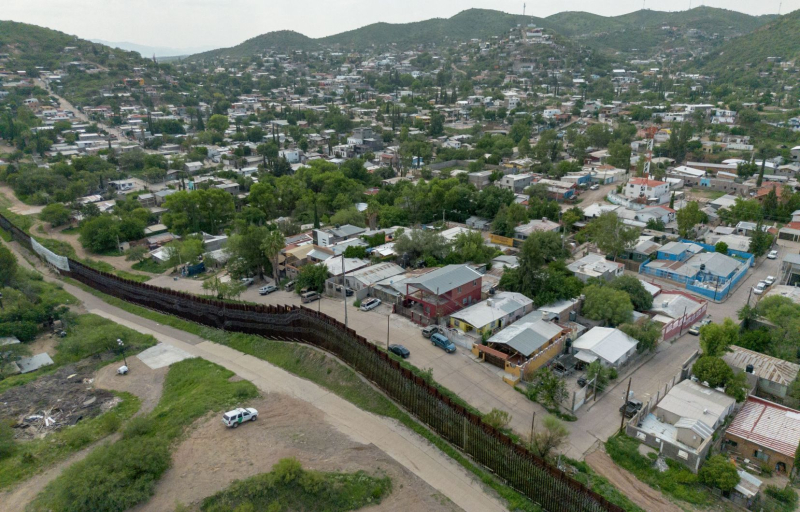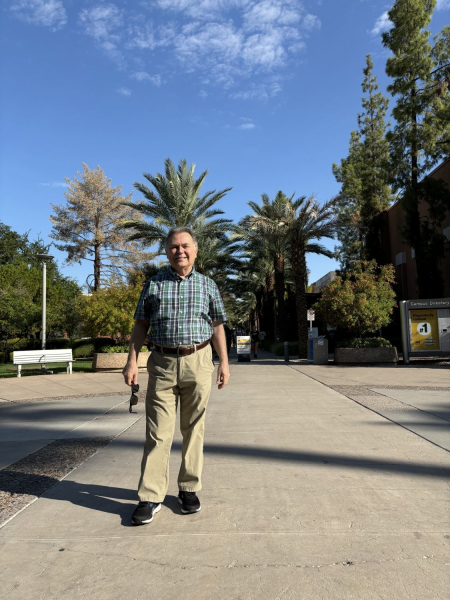
Photo: Daniel Woolfolk Agence France-Presse The border between the United States and Mexico seen from the American side, in Nogales.
Stéphane Baillargeon in Phoenix and Nogales
Posted at 0:00 Updated at 0:28
- United States
In a few weeks, the presidential election in the United States will be decided in a handful of swing states, including Nevada and Arizona, where the Republican and Democratic candidates remain neck and neck. This series offers a political journey through these areas of fierce struggle. Last stop in Nogales, hometown of the writer Alberto Ríos, who speaks of the border with Mexico as a gray area.
Poet and literature professor Alberto Álvaro Ríos traveled three years ago with two friends from Phoenix, where he lives and teaches, to the two Nogales. He wanted to show them his hometown in Arizona and the twin Mexican city of the same name in the state of Sonora across the border.
“Unfortunately, we had all forgotten our passports, so we couldn’t go from one side to the other,” explains Mr. Ríos, whom we met for this political journey in Devoir,from Nevada to Arizona, two swing states in the upcoming US elections. The border and migrants are at the center of the campaign’s obsessions.
Mr. Ríos suggested going to the pedestrian bridge near the old border post to get a glimpse of the Mexican city. Night was falling. Floodlights suddenly came on to illuminate the area around the wall. The trio heard cheers. Young people appeared with a basketball and began playing on the Mexican side on a court lit by the United States.
“We make do with what we have in life,” Alberto Ríos said philosophically. These players had found a way to divert a little of the surveillance at the border to their advantage. »
The anecdote does not appear in Capirotada,published by the writer in 1999. There are many more in this multifaceted book, which offers a mix of memories and reflections on life in Nogales, where the author was born in 1952. It interweaves several literary genres, poetry, essay, memoir, a long confession transcribed by the author's mother and even, at the end, a recipe for bread pudding that gives its title to the whole, the capirotada being like this corner of the world mixing rich improbable ingredients.
The unique work, speaking from the we to the I, was named by the media Arizona Republic as one of the five best books written about this state. With Steven Spielberg in cinema, Linda Ronstadt and Charles Mingus (also born in Nogales) in music or Frank Lloyd Wright (Arizonan by adoption) in architecture, Alberto Ríos completes with letters the pantheon of artistic stars of this corner of the southwest of the United States.
The latter studied literature and became a professor at Arizona State University in 1982, the year he published Whispering to Fool the Wind, which earned him the Walt Whitman Prize. He is considered one of the leading voices in poetry in the United States in recent decades. His work bridges two cultures and two languages, English and Spanish. One reviewer spoke of “written miracles that carry the sensation of another world,” but also of a literature of the frontier “where one is neither in this country nor in the other.”
Read also
- Portrait of the Trumpist activist in training
- Las Vegas, blue-collar city in a purple state
- Sheriff, for better or for worse
From Mexico and England
His poetic, personal and cultural perspective on territorial boundaries seems all the more essential as current sociopolitical events continue to tragically seize upon the subject. The war in Ukraine and the conflicts surrounding Israel are reminders of the importance and complexity of border realities. Migrations are at the center of the political campaign that is ending in the United States as well as at the heart of discussions in Quebec, Canada and Europe.
200% Deposit Bonus up to €3,000 180% First Deposit Bonus up to $20,000Alberto Ríos' father, also named Alberto Álvaro, was Mexican and his mother British. The couple is the epitome of a history of migrations like millions of others in this country of migrants.

Photo: Stéphane Baillargeon Le Devoir Alberto Ríos, a major Arizona writer, is from Nogales.
Born on the Guatemalan border, Alberto Ríos’ father fled his village at age 14 and joined his grandmother and aunts in Nogales, Arizona. He arrived at a time when the border was still porous. He enlisted in the army and was transferred to England, where he met the young Agnes Fogg.
They married: he with “very, very dark” skin, a victim of racial discrimination; she, who had never left her English hamlet. The atypical lovers could have settled elsewhere in America. They chose this two-headed agglomeration on the edge of the Wild West where Papa Ríos ended up becoming a country judge partly responsible for monitoring migration in his adopted country.
A chain, a wall, an idea
The question runs through the entire book: what is a border, basically? ? The answer points to an in-between where worlds collide, constantly oscillating between confrontation and cohabitation.
Capirotada tells the story of the parade that crossed from one side to the other, from Nogales Sonora to Nogales Arizona, without any control, on Cinco de Mayo 1962. “No one worried, because there was no need to worry,” the author writes. “An open border meant just that. It didn’t cause panic or guns. It made for a good day.”
The following year, on November 22, 1963, John Kennedy was gunned down in neighboring Texas. Young Alberto, nicknamed Tito, was in the playground watching a centipede when news of the tragedy spread. “It was a curious moment, perhaps a metaphor for a larger event. Freud says that sometimes a cigar is just a cigar, so maybe the centipede was just a centipede, even though it had all these legs and scared us to death because we had never seen anything like it before.”
« The line” was then sealed off and families separated for the first time. Over time, starting in the 1970s and the “war on drugs,” the dividing line evolved from a simple chain that could be easily crossed to the recent iron wall built under the Trump administration.
“The wall was first an idea, then a fence, then a wall,” the author writes in his book. “I think it's still an idea. In any case, what the fence stops remains very uncertain.”
He adds in the text: “People always talk about the border as this barrier that separates the people in these cities. It's not the border. It's something else, something that highlights the difference between danger and grace, which is not something that separates people. It is something that unites them since they face the same obstacle.”
Problems and solutions
The border is obviously used to bring people and things into the North. Estimates suggest that 40% of the fentanyl brought into the United States passes through Nogales, an increase of 2,000% in ten years.
“There are very real problems related to the border,” the poet said in an interview with Devoir. “Only, no one is really trying to solve them. In fact, the border problem is so politicized that it seems impossible to talk about solutions. We talk instead about punishments, repression, we try to appease ignorance. In truth, farmers need the seasonal labor provided by migration.”
A few months ago, Mr. Rios visited the border again, but near Yuma, the other major gateway to the state. This time, he was in the company of a very big American celebrity who wanted to get involved through his charitable foundation in Arizona — the writer gives the name of the Hollywood star, but asks that it not be published, since he himself is still sworn to secrecy. The first lady, Jill Biden, returned to the city to campaign for the Democratic nomination last week.
“In Yuma, you see the iron wall and then it stops and doesn’t cross an indigenous reservation,” says Alberto Rios. “It’s ridiculous. When we passed there, migrants had gathered on the American side, 12, maybe 15 people. People from Mexico, a mother from Guatemala with her baby who had traveled on foot for six months working along the way, and a Russian family too.”
The group was waiting for the border guard to be arrested and fill out official documents. “Our guide told us that when a politician visits this section, the police let the migrants pile up for several days because it makes for more dramatic images. That’s the border too…”
This report was funded with support from the Transat International Journalism Fund-Le Devoir.

